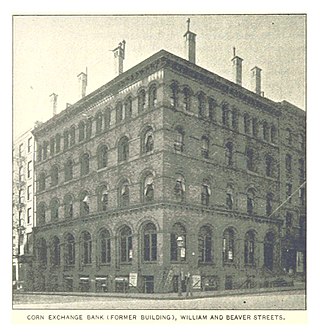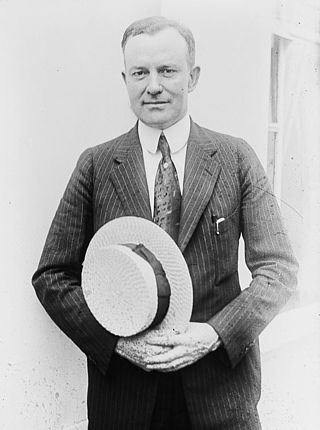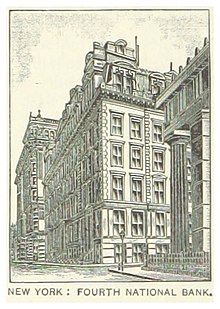Chemical Bank was a bank with headquarters in New York City from 1824 until 1996. At the end of 1995, Chemical was the third-largest bank in the U.S., with about $182.9 billion in assets and more than 39,000 employees around the world.

George Opdyke was an entrepreneur and the 76th Mayor of New York City during the American Civil War. The New York City draft riots occurred during his tenure.
J.P. Morgan & Co. is an American financial institution specialized in investment banking, asset management and private banking founded by financier J. P. Morgan in 1871. Through a series of mergers and acquisitions, the company is now a subsidiary of JPMorgan Chase, one of the largest banking institutions in the world. The company has been historically referred to as the "House of Morgan" or simply Morgan. For 146 years, until 2000, J.P. Morgan specialized in commercial banking, before a merger with Chase Manhattan Bank led to the business line spinning off under the Chase brand.

Morris Ketchum Jesup, was an American banker and philanthropist. He was the president of the American Museum of Natural History and was known as a leading patron of scientific research and an eminent art collector, particularly towards his support for Frederic Edwin Church.
Irving Trust was an American commercial bank headquartered in New York City that operated between 1851 and 1988 when it was acquired by Bank of New York. From 1965, the bank was the principal subsidiary of the Irving Bank Corporation.

KeyBank, the primary subsidiary of KeyCorp, is an American regional bank headquartered in Cleveland, Ohio. Key ranked 449th on the 2022 Fortune 500 list based on its 2021 revenue. It is 25th on the list of largest banks in the United States.

Manufacturers Hanover Corporation was the bank holding company formed as parent of Manufacturers Hanover Trust Company, a large New York bank formed by a merger in 1961. After 1969, Manufacturers Hanover Trust became a subsidiary of Manufacturers Hanover Corporation. Charles J. Stewart was the company's first president and chairman.

MUFG Bank, Ltd. is a Japanese bank. Its headquarters is located in Marunouchi, Chiyoda, Tokyo, and it has 772 domestic branches and 76 overseas branches. It was established on January 1, 2006 through the merger of the Bank of Tokyo-Mitsubishi, Ltd and UFJ Bank Limited. MUFG Bank, along with Sumitomo Mitsui Banking Corporation and Mizuho Bank, is recognized as one of the three major megabanks in Japan.
Morris Ketchum was a prominent American banker and financier of the 19th century.

The Corn Exchange Bank was a retail bank founded in 1853 in New York state. Over the years, the company acquired many community banks.

The Brooklyn Trust Company was a bank in New York City. Chartered in 1866, the Brooklyn Trust Company originally offered trust management and estate management services but also functioned as a commercial bank. The Brooklyn Trust Company acquired over a dozen smaller banks throughout its existence, merging with the Manufacturers Trust Company in 1950.

Walter William Head was an American banker and insurance executive. He was president and founder of the General American Life Insurance Company, now a part of MetLife, and president of the American Bankers Association. Head also served as national president of the Boy Scouts of America for nearly twenty years, from 1926 to 1946.

The Mechanics and Metals National Bank (MMNB) was a bank in New York City, founded in 1810 as the Mechanics National Bank. In 1910, it merged with National Copper Bank and took the Mechanics and Metals National Bank name. After a number of mergers and acquisitions, in 1926 MMNB consolidated with the Chase National Bank.
The New York Trust Company was a large trust and wholesale-banking business that specialized in servicing large industrial accounts. It merged with the Chemical Corn Exchange Bank and eventually the merged entity became Chemical Bank.
The Chatham Phenix National Bank and Trust Company was a bank in New York City connected with the Chatham Phenix Corporation. Its predecessor Chatham and Phenix National Bank was formed in 1911 when Chatham National Bank paid $1,880,000 to absorb the asset of the Phenix National Bank. The bank grew significantly as it absorbed smaller banking institutions, such as Mutual Alliance Trust Company and Century Bank in 1915, at which point Chatham and Phenix National Bank became the "first national bank to operate branches in the same city with the main bank."

Gates White McGarrah II was a prominent American banker who served as the first president of the Bank for International Settlements.

Joseph Edward Simmons was an American lawyer and banker who served as president of the New York Stock Exchange, the New York Clearing House and of the New York Chamber of Commerce.
Philo Clark Calhoun was an American industrialist, banker, and politician who served as president of the Fourth National Bank of New York.
The National Bank of Commerce in New York was a national bank headquartered in New York City that merged into the Guaranty Trust Company of New York.
The Metropolitan Trust Company of the City of New York was a trust company located in New York City that was founded in 1881. The trust company merged with the Chatham and Phenix National Bank in 1925 under the name of the Chatham Phenix National Bank and Trust Company of New York.












